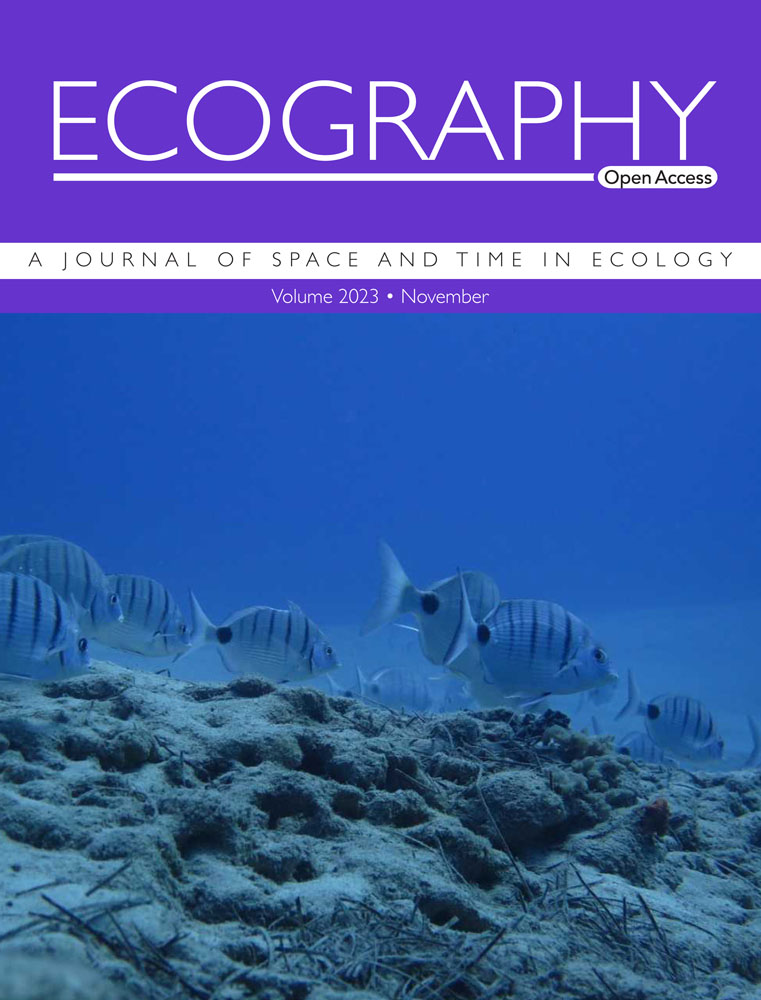水分有效性和进化相似性决定了蕨类植物叶绿素孢子的全球分布
IF 4.7
1区 环境科学与生态学
Q1 BIODIVERSITY CONSERVATION
引用次数: 0
摘要
大约14%的蕨类植物有叶绿素孢子,这些孢子缺乏休眠,壁薄,存活时间较短(某些物种只有几天)。这些孢子应该有有限的传播距离,更容易受到恶劣气候条件的影响,这就提出了关于这种特征的进化和生态意义的问题。在这里,我们收集了叶绿素孢子蕨类植物的全球分布,并评估了潜在的环境和进化因素。我们首先利用广义线性混合模型评估了577个地理区域1387种叶绿素孢子物种(CSS)比例代表性的环境预测因子。然后,我们估计了孢子类型的系统发育信号,并评估了环境因素在蕨类组合系统发育结构中的相对重要性。物种丰富度在热带地区最高,比例代表性在温带和海岛区系最高。CSS的比例与水分可用性和较少的季节性气候呈正相关。孢子类型在系统发育上高度保守,CSS组合在系统发育上向高纬度聚集。我们的研究提供了强有力的证据,证明叶绿素孢子并不限制蕨类物种的地理分布,它们的纬度分布模式可以用环境和进化因素的组合来解释。本文章由计算机程序翻译,如有差异,请以英文原文为准。
Water availability and evolutionary similarity shape the global distribution of ferns with chlorophyllous spores
About 14% of all fern species have chlorophyllous spores, which lack dormancy, have thin walls, and have a shorter viability (only a few days in some species). These spores should have limited dispersal distances and be more susceptible to harsher climatic conditions, raising questions about the evolutionary and ecological significance of this trait. Here, we assemble the global distribution of chlorophyllous‐spored ferns and assess the underlying environmental and evolutionary factors. We first evaluated the environmental predictors of the proportional representation of 1387 chlorophyllous‐spored species (CSS) across 577 geographical regions using generalized linear mixed models. We then estimated the phylogenetic signal of spore type and assessed the relative importance of environmental factors in the phylogenetic structure of fern assemblages. Species richness of CSS peaked in the tropics, while their proportional representation was highest in temperate and island floras. The proportion of CSS was positively associated with water availability and less seasonal climates. Spore type was strongly conserved phylogenetically, and CSS assemblages were phylogenetically clustered towards higher latitudes. Our study provides strong evidence that chlorophyllous spores do not limit the geographical distribution of fern species and that their latitudinal distribution patterns can be explained by a combination of environmental and evolutionary factors.
求助全文
通过发布文献求助,成功后即可免费获取论文全文。
去求助
来源期刊

Ecography
环境科学-生态学
CiteScore
11.60
自引率
3.40%
发文量
122
审稿时长
8-16 weeks
期刊介绍:
ECOGRAPHY publishes exciting, novel, and important articles that significantly advance understanding of ecological or biodiversity patterns in space or time. Papers focusing on conservation or restoration are welcomed, provided they are anchored in ecological theory and convey a general message that goes beyond a single case study. We encourage papers that seek advancing the field through the development and testing of theory or methodology, or by proposing new tools for analysis or interpretation of ecological phenomena. Manuscripts are expected to address general principles in ecology, though they may do so using a specific model system if they adequately frame the problem relative to a generalized ecological question or problem.
Purely descriptive papers are considered only if breaking new ground and/or describing patterns seldom explored. Studies focused on a single species or single location are generally discouraged unless they make a significant contribution to advancing general theory or understanding of biodiversity patterns and processes. Manuscripts merely confirming or marginally extending results of previous work are unlikely to be considered in Ecography.
Papers are judged by virtue of their originality, appeal to general interest, and their contribution to new developments in studies of spatial and temporal ecological patterns. There are no biases with regard to taxon, biome, or biogeographical area.
 求助内容:
求助内容: 应助结果提醒方式:
应助结果提醒方式:


